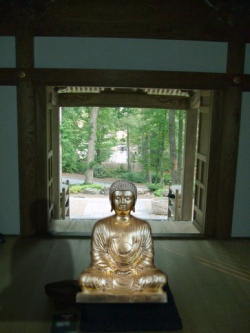Nara period
Nara Period; The Nara period (奈良時代 Nara jidai?) of the history of Japan covers the years from AD 710 to 794. Empress Gemmei established the capital of Heijō-kyō (present-day Nara). Except for a five-year period (740–745), when the capital was briefly moved again, it remained the capital of Japanese civilization until Emperor Kammu established a new capital, Nagaoka-kyō, in 784, before moving to Heian-kyō, or Kyoto, a decade later in 794.
Most of Japanese society during this period was agricultural in nature and centered around villages. Most of the villagers followed a religion based on the worship of natural and ancestral spirits called kami.
The capital at Nara was modeled after Chang'an, the capital city of Tang China. In many other ways, the Japanese upper classes patterned themselves after the Chinese, including adopting Chinese written characters (Japanese: kanji), fashion, and the religion of Buddhism.
